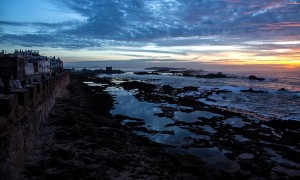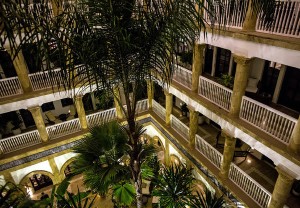by Elaine Glusac
On a sandy curb, one dune away from the crashing Atlantic surf, a wiry vendor in a blue plastic chair with baskets of razor clams and oysters at his feet scissored open a spiky purple sea urchin, balancing a cardboard strip on his lap as a cutting board. He made a great show of washing a stainless steel spoon, which my husband and I shared to scoop out the creamy orange shellfish within.
Four of these small urchins cost the equivalent of a dollar and were the bright culinary surprise of coastal Morocco, a country better known for slow-cooked stews. More than its desert and mountainous interior, Morocco’s west coast, a blustery stretch of North Africa, testifies to its colonial past and trading heritage in a series of historic forts and emerging ports along miles of deserted beaches.
Morocco’s northern Mediterranean coast might be the country’s more established shoreline, where a Ritz-Carlton resort is currently under construction, and which is friendlier to swimmers, compared with the wave-bashed west coast. But along some 200 miles of windswept Atlantic beach south of Casablanca, seaside meadows sprout billboards touting planned resorts and vacation home communities, suggesting that Morocco’s second coast is poised to boom. Already a string of stylish, mostly boutique hotels have opened there, giving travelers reasons to stop and stay.
In 2001, King Mohammed VI announced a strategy to lure 10 million annual visitors to Morocco that involved improving infrastructure and highlighting key regions for development. Known as Plan Azur, it suggested developing a handful of beach resorts to complement existing Agadir, an already popular six-mile beach lined with grand resorts about 300 miles south of Casablanca.
“People from the U.S. go to Morocco for culture, food and shopping,” said Chakib Ghadouani, director of the Moroccan National Tourist Office in New York, in an interview. “Mostly Europeans love going to the beach in Morocco. And Moroccans too.”
As nature-loving Americans, my husband, my 15-year-old son and I found, over a four-day spring road trip in April 2014, that connecting the historic port towns between Casablanca and Essaouira, about 215 miles south, offered an explorer’s version of a shore holiday, more beachcombing than pool hopping. Mass tourism may be coming to Morocco’s Atlantic coast, but the windy, wave-pounded shore remains rugged, with occasional surf breaks noted in handwritten signs.
“It’s beautiful, and an unexpected part of Morocco,” said Jim Berkeley, the president of California-based Destinations & Adventures International, who frequently travels in Africa and the Middle East and who visited the coast for the first time this fall.
Following the two-lane road that skirts the coast south of Casablanca, we drove past long, narrow ribbonlike farms of wheat and mixed crops that ran undulating down to the dune-lined beach. Homemade scarecrows dressed in pointed black hoods cropped up in the fields, vibrant oranges and huge artichokes were piled on roadside produce stands, and donkey carts slowly trucked harvests home. This 19th-century agrarian scene was occasionally interrupted by development billboards announcing projects such as Les Jardins de L’Ocean and Ola Blanca, among others, many of which are still under construction.
One exception is Mazagan Beach and Golf Resort, a large-scale family resort about an hour south of Casablanca, opened in late 2009 by Kerzner International, which also owns the sprawling Atlantis resort in the Bahamas. The 600-acre property, which a few weeks ago opened its 10th restaurant, a sushi bar, hosts a Gary Player golf course, Morocco’s largest casino and 500 rooms with access to miles of undeveloped beach where guests can ride horses or camels.
We passed it up for the nearby town of El Jadida, where history and hospitality blend harmoniously. Originally called Mazagan, the city’s historic center is a 16th-century Portuguese walled fort, now a Unesco World Heritage site enshrined for its Renaissance military design. Bastions and ramparts circumscribe the village and dared us to squeeze our rental Skoda four-door through an arched entry in the walls with just inches to spare.
In 2013, the owners of the stylish hotel and golf resort Beldi Country Club near Marrakesh converted a 19th-century Spanish church in the ancient heart of El Jadida into the eight-room boutique Hotel L’Les Jardins de L’Ocean and Ola Blanca,Iglesia, the walled city’s first such hotel. Since then, it has expanded to include five rooms and a restaurant in the former United States Consulate, a stately, three-story colonial annex two blocks away, where we checked into a spacious room with an iron-frame bed, vintage armchairs and an antique wooden armoire. Its French doors opened to views of the laundry line across the lane, where rugs flapped like patterned flags.
Reaching it required easing past a block of shops that sprang forth each morning onto the cobbled roadway, hawking inlaid wooden boxes, tea sets and paintings to day-trippers who come to walk the ancient stone walls that ring the old town and descend into an atmospheric cistern. The spooky subterranean reservoir of stone pillars and brick arches was a moody set for Orson Welles’s 1952 film “Othello” and remained compelling to the iPhone cinematographers around us.
By day, the owners of the hotel also run a lunch spot, Café Do Mar, in one of the old mansions. Its two terraces overlook the town gates to the sea through which shellfish divers came and went, breaking up children’s soccer games as they passed. Virtually vacant at night, the fortress center was a silent 16th-century mirage. We traipsed between the hotel’s two buildings, first visiting the former church for a glass of complimentary rosé in the antiques-filled sanctuary-turned-lounge, then returning to the hotel restaurant for beef and apricot tagine, the only meal within the walls after sundown.
While our mostly European fellow guests used L’Iglesia as a quiet base from which to explore the coast on foot and by car, returning nightly, we motored on an hour south to Oualidia, a center for oyster farming where we ate those bivalves and sea urchin on the oceanfront street. Similar-minded families built sand castles and picnicked between the wooden fishing boats with pointed prows beached on the sloping dune as fishermen carried away their catch in buckets. Recreational fishermen cast lines from rock peninsulas that sheltered a cove, but even in the spring the steady wind made it too cold to dip much more than a toe in the ocean.
The sea urchin was just an appetizer before a more elaborate meal at the exclusive La Sultana Oualidia resort, a 12-room palacelike hotel constructed on the edge of town in stone with an Italianate central tower overlooking a broad saltwater lagoon opposite the dunes. We made a (mandatory) reservation for lunch on the beachfront deck where, shaded by sail-like canopies, we dined on just-shucked oysters, crab salads and chilled pinot gris. Private launches whisked guests to the remote dunes for picnics, though the general manager, Khalil Guerraoui, noted that they rarely went farther.
“Ninety percent of our guests don’t leave,” he said. “They come for the peace.”
South of Oualida, orange groves staked the hillsides and bushy cactus bordered the roads. Two hours later, Essaouira bookended our beach crawl with another car-confounding narrow passage within its ancient walls, this time chased down by a policeman who informed us the old city was pedestrian only. At our riad-style hotel, Heure Bleue Palais, a porter sporting a red fez that seemed disproportionately dainty to his hulking size, emerged to whisk away our bags and escort us to its palm-filled courtyard for welcome cookies, dates and freshly squeezed orange juice.
The still teeming walled city was a major trade port between Europe and Africa in the 18th and 19th centuries. Though popular with day-trippers from inland Marrakesh, about 110 miles east, Essaouira remains an active harbor jammed with fishing trawlers and small dories painted the signature sky blue hue of the city. A cluster of seafood restaurants in front of the port displayed enticing collages of prawn, lobster, eel, crab and a spectrum of fish on ice as waiters vied to hustle tourists to their tables.
Marine and desert cultures meet in Essaouira, where walks atop the honey-hued walls offer expansive sea views and escape from the cramped quarters of the central medina. Like a slightly less disorienting version of the central souk in Marrakesh, where travelers can easily get turned around, the stalls in Essaouira’s marketplace similarly overflowed with everything from spices and produce to collectible pottery, weavings and inlaid wooden boxes. Artists arranged their work along the city walls, offering endless opportunities to exercise our newly honed skills at bargaining.
The city’s beaches swing south about a mile and a half along a bay popular with windsurfers where resort options include the 175-room Sofitel Essaouira Mogador Golf and Spa, a Plan Azur-inspired enclave that just opened a 13-hole golf course, supplementing its existing 18-hole Gary Player golf course, five restaurants and a spa. We found it easy enough to walk to the beach from our hotel within the walls, allowing us to steep in the history and culture of the old city with periodic shore leave for psychic balance.
IF YOU GO
The biggest resort on the northern coast, Mazagan Beach and Golf Resort, houses the country’s largest casino, several restaurants and kids’ clubs entertaining infants to teens. Rooms from 1,775 dirhams, or $185 at 9.50 dirham to the dollar; mazaganbeachresort.com.
In El Jadida, 14 antiques-filled rooms are split between a former church and former American Consulate at Hotel L’Iglesia. Rooms from 1,500 dirhams; liglesia.com.
A 12-room hideaway on a saltwater lagoon, La Sultana Oualidia has a private beach and infinity pool and offers boat trips. Rooms from 3,100 dirhams; lasultanahotels.com/oualidia.
In the walled heart of Essaouira, elegant Heure Bleue Palais features a palm-filled courtyard, rooftop pool and mini hammam. Rooms from 1,840 dirhams; heure-bleue.com.
Correction: December 29, 2015
An earlier version of a picture caption with this article located a beach on the Moroccan coast incorrectly. It is in Essaouira, not El Jadida.
(photo 1: The beach by Essaouira, where ramparts surround the village. Daniel Rodrigues for the New York Times)









